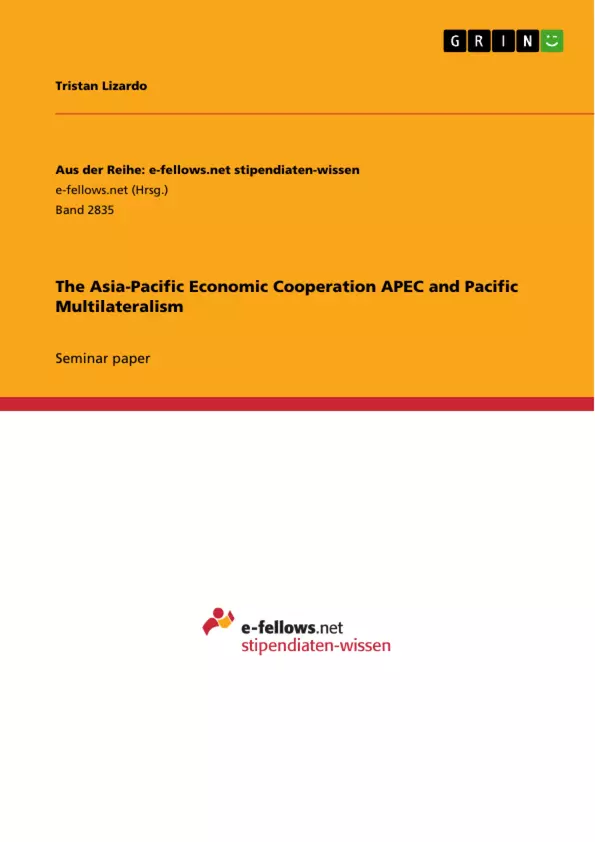The “Asia-Pacific Economic Cooperation” (APEC) was established in 1989, and holds 21 so called member economies, all located on the Pacific Rim. Each member represents a particular economic region rather than individual states which is illustrated in Exhibit 1. APEC’s main goal is promoting “sustainable economic growth and prosperity in the Asia-Pacific region” (Achievements and Benefits, 2016). This is supposed to be reached primarily by the establishment of the Free Trade Area of the Asia-Pacific (FTAAP). However, APEC is working on many different topics and various alliances have been formed in order to enable free trade and investment, good cooperation among members, regional economic integration, enhancing human security and facilitating a favorable sustainable business environment in the Asia-Pacific.
The organization works as a cooperative and multilateral economic trade forum. A defining characteristic of APEC is that it is the only international intergovernmental bundling in the world aiming to reduce trade barriers to trade and investment without postulating legal binding contracts and therefore encourages participation and structural flexibility.
APEC has enjoyed great success as an international forum for discussion among the world’s leaders in politics, business and academia. However it has made limited progress in regional integration and cooperation in areas such as financial infrastructure with a slow response time to emerging world trends.
Inhaltsverzeichnis (Table of Contents)
- Introduction
- APEC's Mission
- APEC's Organizational Structure
- Comparing APEC to other Pacific Multilateral Organizations
- APEC
- TPP
- ASEAN
- Analysis of APEC's Strength and Weaknesses
- Pillar One: Business Facilitation
- Pillar Two: Trade and Investment Liberalization and Facilitation
- Pillar Three: Economic and Technical Co-operation
- Conclusion: APEC Going Forward
Zielsetzung und Themenschwerpunkte (Objectives and Key Themes)
The Asia-Pacific Economic Cooperation (APEC) forum was established in 1989 with the goal of promoting sustainable economic growth and prosperity in the Asia-Pacific region. This is achieved through the implementation of various initiatives and agreements aimed at fostering free trade, investment, and economic cooperation between member economies.
- Economic growth and prosperity in the Asia-Pacific region
- Free trade and investment
- Regional economic integration
- Sustainable business environment
- Cooperation among members
Zusammenfassung der Kapitel (Chapter Summaries)
The introduction provides an overview of APEC, its member economies, and its mission to promote sustainable economic growth and prosperity in the Asia-Pacific region. It discusses the challenges of implementing policies across economies with varying development levels and the importance of achieving free trade and investment in the region.
The chapter on APEC's mission details the three pillars of the Bogar Goals, adopted in 1994: Business Facilitation, Trade and Investment Liberalization, and Economic and Technical Cooperation. These pillars outline the framework for achieving APEC's goals, focusing on reducing trade barriers, promoting investment, and enhancing cooperation on economic and technical issues.
The chapter on APEC's organizational structure discusses its unique cooperative and multilateral approach to economic trade, highlighting its focus on promoting trade and investment without imposing legally binding contracts. This structure facilitates flexibility and encourages participation among its members. This section also discusses the strengths and weaknesses of APEC, acknowledging its success as a forum for discussion while noting its limited progress in areas like financial infrastructure.
The chapter on comparing APEC to other Pacific Multilateral Organizations analyzes APEC's unique characteristics and approaches in contrast to other regional organizations like TPP and ASEAN. It discusses the strengths and weaknesses of each organization in terms of their specific goals and mechanisms for achieving them.
The chapter on the Business Facilitation pillar elaborates on APEC's efforts to reduce the time, cost, and uncertainty of doing business within the region. This includes measures like developing and harmonizing policies to improve market access and efficiency, and maintaining public interest through safeguards for health and safety.
The chapter on the Trade and Investment Liberalization pillar focuses on APEC's initiatives to reduce tariff and non-tariff barriers to trade and investment. This involves creating systems with common standards, simplifying customs procedures, and facilitating the movement of goods across the region. The chapter highlights the development of the Single Window system and the role of APEC in guiding bilateral and regional trade agreements.
The chapter on the Economic and Technical Cooperation (ECOTECH) pillar examines APEC's efforts to advance trade, investment, and economic growth in a sustainable manner. This includes initiatives focused on strengthening anti-corruption measures, promoting cross-border education and skills training, enhancing emergency preparedness, ensuring energy security, protecting the environment, combating pandemics, and developing infrastructure across the region.
Schlüsselwörter (Keywords)
The primary focus of this text is on the Asia-Pacific Economic Cooperation (APEC) forum and its role in promoting economic growth, free trade, and investment in the region. Key concepts explored include regional economic integration, multilateralism, sustainable development, business facilitation, trade liberalization, investment facilitation, and economic and technical cooperation.
- Citation du texte
- Tristan Lizardo (Auteur), 2016, The Asia-Pacific Economic Cooperation APEC and Pacific Multilateralism, Munich, GRIN Verlag, https://www.grin.com/document/441369



